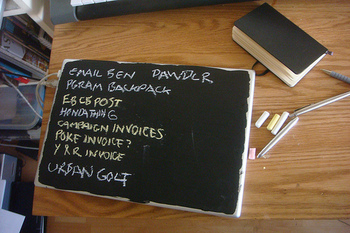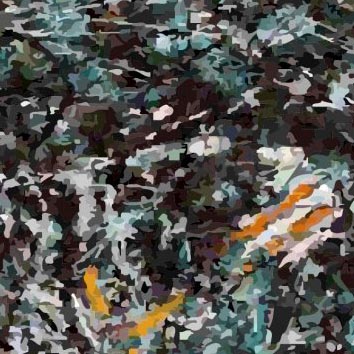MTAA-RR:
May 23, 2008
Horvath gets BoingBoing’d
posted at 20:31 GMT by T.Whid in /news/twhid
Congrats Peter, you’ve just gained an entirely new audience! Hope your bandwidth bill is paid up… permanent link to this post
May 22, 2008
AutoTrace #1 (Full Fathom Five), 2005
posted at 13:43 GMT by T.Whid in /news/twhid
May 21, 2008
Blackboard pro = dumb
posted at 15:43 GMT by T.Whid in /news/twhid

Why do two (1,2) über-geeks think this is a good idea?
It’s a mind-boggingly stupid idea: #1 chalked-up sleeves; #2 erased messages via the chalked-up sleeves; and #3 you can’t see the to-dos when you’re using your computer (assuming at least *some* of the to-dos would have to be done with the computer). update: Not to mention the dust problem that the Boing Boing commenters point out.
It’s only a good idea if you never, ever remove the laptop from your desk and never open it. Sometimes the techno-nerds really lose all perspective. permanent link to this post
May 20, 2008
Orphan Artworks Bill
posted at 15:54 GMT by T.Whid in /news/twhid
I have to admit that I have no idea what to make of this proposal. But I outsource all my opinions regarding copyright to Lessig so I guess I’m against it.
update
More on this from the Electronic Frontier Foundation (they strongly support it). permanent link to this post
May 17, 2008
Oreilly remix
posted at 14:51 GMT by T.Whid in /news/twhid
May 14, 2008
Chicago: feast on foie gras!
posted at 20:42 GMT by T.Whid in /news/twhid
I only mention it now as it’s been discussed here before.
The thing that really irritates me about these foie gras bans is that the true food demons in our culture — large factory farms — have too much clout for animal activists to have any affect. So they end up picking on small, artisanal farmers creating a relatively rare delicacy.
M.River adds = Here is a NYT article on the “artisanal farmers” of foie gras - No Days Off at Foie Gras Farm.
T.Whid adds… er, ah… oops permanent link to this post
May 13, 2008
Rauschenberg dead!
posted at 14:49 GMT by T.Whid in /news/twhid
May 10, 2008
Church of the Rough Guide at OTO
posted at 14:16 GMT by M.River in /news/mriver

Photographs from the Church of the Rough Guide at OTO last night are now up at Flicker. Yes, some people ate the shrimp off the walls.
OTO’s Flickr set permanent link to this post
May 09, 2008
…as goofy and perplexing and overwhelming and sad as the Internet itself
posted at 16:05 GMT by T.Whid in /news/twhid
WANT, a collaboration between MTAA and Radical Software Group, uses 900 video clips of actors to illustrate search-engine requests. It’s as goofy and perplexing and overwhelming and sad as the Internet itself. The next time you use a search engine with one of those “Other users are currently searching for . . .” features, you won’t be able to resist picturing the forlorn, chubby face that goes with the query for “SALMA HAYEK EATING COOKIES.”
via Get Plugged In By ‘LIVE,’ the New Art Show at UC Irvine’s Beall Center for Art and Technology (OC Weekly ) permanent link to this post
May 08, 2008
Getty goat
posted at 14:20 GMT by T.Whid in /news/twhid
May 07, 2008
Hasan Elahi on Colbert Report TONIGHT!
posted at 18:40 GMT by T.Whid in /news/twhid
Tonight (May 7)
The Colbert Report
Comedy Central
11:30 (Eastern and Pacific)/10:30 (Central and Mountaln)
I’m going to be on The Colbert Report discussing my project, “Tracking Transience” and how do deal with being on a terrorist watchlist. Stephen Colbert is supposedly doing a little story on Nelson Mandela still being on the terrorist watchlist…I guess Mandela was unavailable, so they called me.
We met Hasan at the Creative Capital retreat in ‘06. If only all the terrorists on the watchlists were like Hasan, the world would be a happy place…
If you don’t know Hasan’s project, “Tracking Transience,” you should check it out! permanent link to this post
May 06, 2008
Conflux 08
posted at 15:34 GMT by M.River in /news/mriver

Conflux 07 - MTAA’s Super Slow 5k
Conflux is the annual art and technology festival for the creative exploration of urban public space. The 2008 festival takes place September 11 - 14 throughout New York City. You can now submit a proposal to participate in the 08 festival here.
The deadline is May 31, 2008. permanent link to this post
Nick Lesley and Eben Lillie’s Church of the Rough Guide
posted at 12:42 GMT by M.River in /news/mriver

On May 9, from 7pm to 10pm, Over The Opening is please to present “Church of the Rough Guide”, a new installation by Nick Lesley and Eben Lillie. “Church of the Rough Guide” continues the themes and characters found in recent their performance “Rough Guide to the Grotesque”.
“Church of the Rough Guide” is devoted to the lessons of the “Rough Guide to the Grotesque” as written by the great travel writer, Boreas. “Rough Guide to the Grotesque” is a tall tale that depicts an idealistic hero whose principles live on in all of us today. On a quest for love and companionship he faced many dangers. He was deceived by a false idol of love and engaged in a battle of sexual appetites with his apparent soul mate, Sophia of the Forest. He died tragically shortly after finding happiness in joining the Caridea tribe; a juicy, fleshy commune. The story contains lessons of love, comradery, lust, and community which are valuable to us all.
The performance of “Rough Guide to the Grotesque” was made possible with the help of the cast, The Living Theatre, Materials for the Arts, and the House of Yes (RIP). The work premiered at The Living Theatre in April of 2008.
Rough Guide To The Grotesque
permanent link to this post
May 03, 2008
Ah, the good ole days
posted at 00:14 GMT by T.Whid in /news/twhid
Introduction
MTAA for Website Unseen #98 (ed: this piece no longer works in contemporary browsers FYI) with support from MT Science.
This introduction will cover the main themes of the larger study soon to be published. The comparison of apples and oranges should be viewed within the 3 main aspects of fruit usage in the United States. These aspects being (1) pleasure, (2) nutrition and (3) decorative display. This study compares apples and oranges within the cultural and national boundaries of the United States.
Areas used for comparison in this study.
1. Color
2. Shape and Texture (includes skin and meat)
3. Taste
4. Nutritional Value
5. Economics (includes price and availability)
6. Traditional and Non-Traditional Uses
I. COLOR
MTAA conducted comparison tests of the colors of the two fruits with these criteria in mind. 1) In what quantity does the fruit’s color promote appetite for it, i.e. does the red color of a granny smith promote greater appetite than the orange color of a Sunkist. (For the purposes of this study we’ve included only red apples and no golden or yellow.) 2) Does the color promote each fruit’s decorative display in a domestic or commercial setting, including dining room tables, sideboards, coffee tables, kitchen tables, etc in domestic settings and retail furniture outlets. Boardroom tables, reception desks and marketing and/or advertising materials were judged in non-fruit related industries. These studies involved interviews with lay people and professionals who generally use fruit as decorative devices. MTAA also used laboratory studies designed to elicit responses from subjects as to their proclivity to either apples or oranges as decorative devices. We used only color in these studies and experiments and did similar experiments using shape and texture as the criteria.
II. SHAPE AND TEXTURE
MTAA compared these characteristics using the same criteria with similar sampling and testing procedures as the color tests. We measured how the shape and texture promoted appetite and decorative display. These tests were conducted both through visual inspection of shape and texture as well as through a tactile inspection i.e. a “feel” test. With the tactile test MTAA added an identifier section, quantifying which fruit was more easily identified through touch.
III. TASTE
MTAA conducted numerous taste tests using people, monkeys, rats and parrots as testers. With each test group we tested which fruit was more preferred. A Crave Test was also conducted, which measured which fruit was more craved by the test groups. The Crave Test is methodologically very complicated and the details will be published in the full study but it measures how often the test subjects thought of, visualized, or sought after the fruit.
MTAA also tested the taste and crave-ability of prepared foods that use the two fruits as a main ingredient including juices.
IV. NUTRITIONAL VALUE
Using data from the USDA, MTAA compared the nutritional values of the fruits as well as a number of prepared foods that use the fruits as a main ingredient.
V. ECONOMICS
MTAA compared the availability and price during different times of the year in different parts of the US using empirical data provided by the National Apple Growers Association and the National Orange Growers Association. MTAA have also created a comprehensive price/nutrition ratio for all parts of the country for the year 1998.
VI. TRADITIONAL AND NON-TRADITIONAL USES
MTAA did extensive anthropological research into the uses of the two fruits in different cultural contexts such as ingredients in recipes, prominence in religious ceremonies, use as motivational awards, depiction in art and architecture, and general status symbols within different cultural categories. These categories included the contemporary dominant culture of the US, contemporary and historical subcultures, indigenous populations, and small-scale societies both contemporary and historical.
These studies yielded data with which MTAA could create an “Importance Factor” within each cultural category.
The wealth of information which these comparison studies yeilded is currently being analyzed at the MT Science Labs. MTAA forecast a 2004 release of the Comparative Study of Apples and Oranges.
published 2/28/00 permanent link to this post

